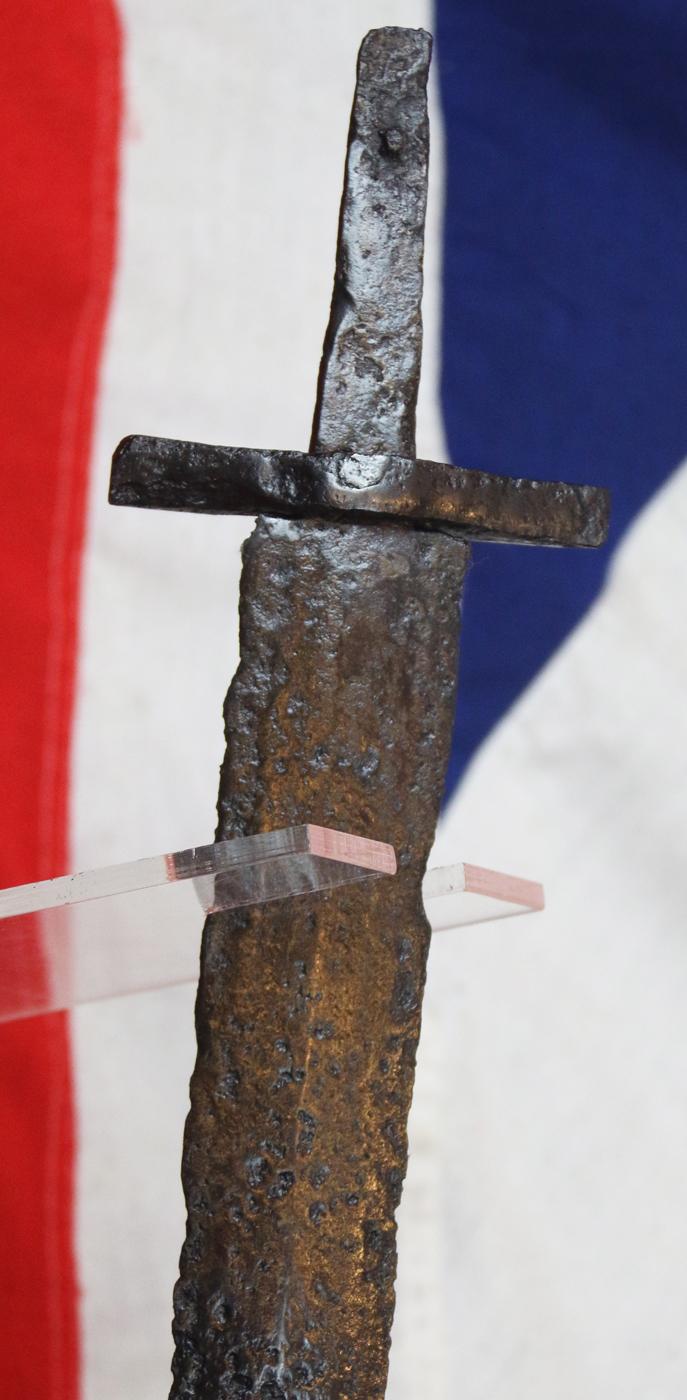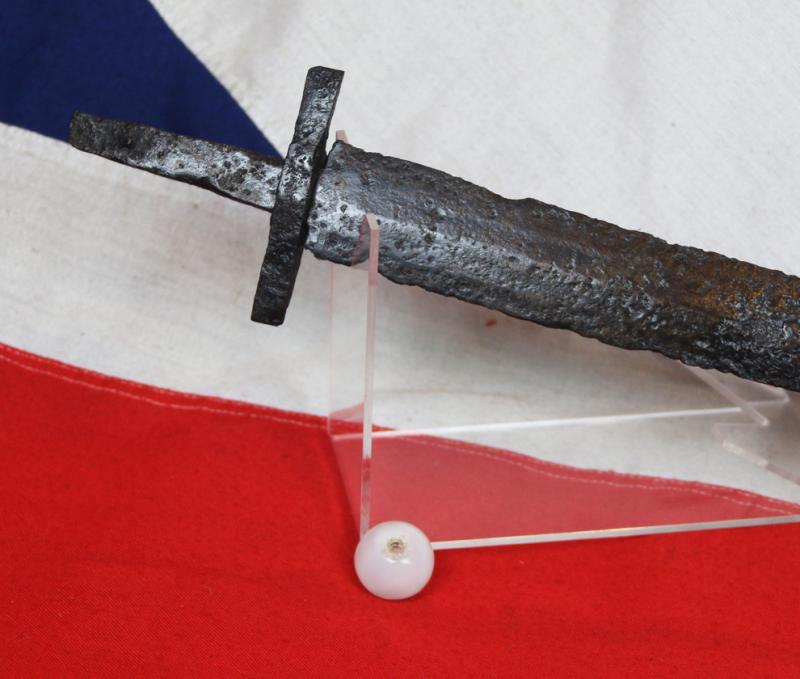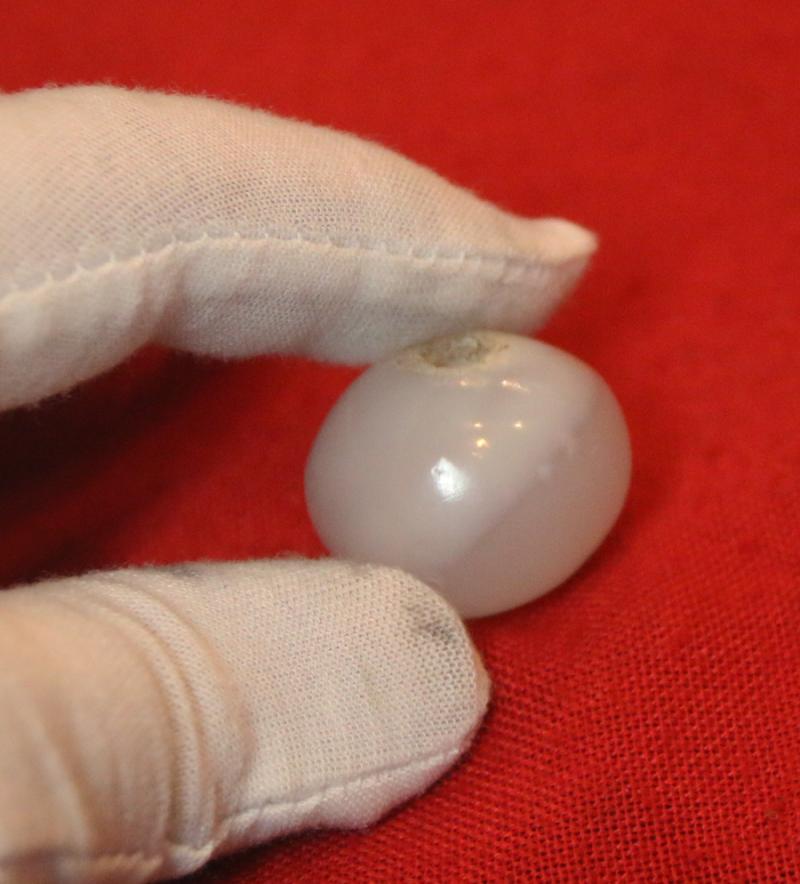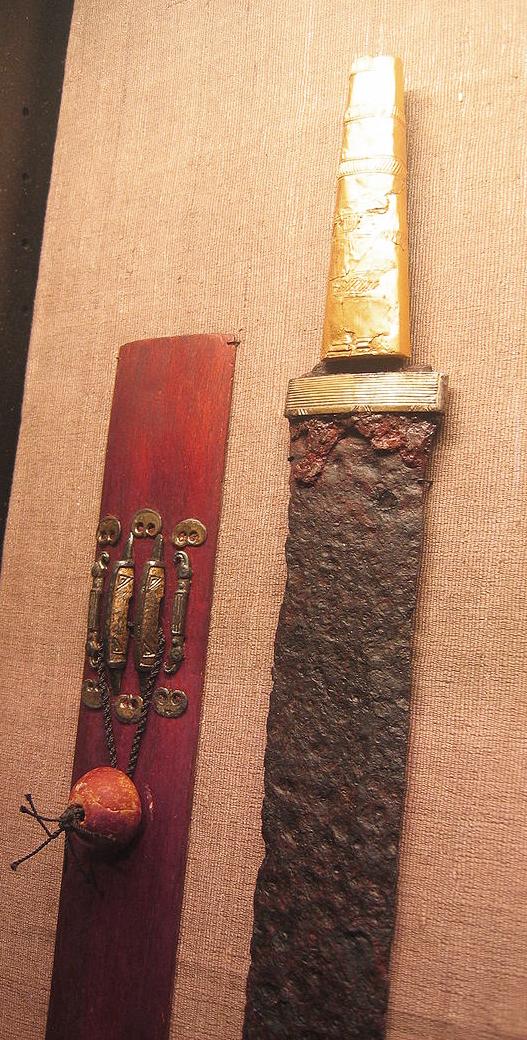An Exceptional 1700 to 1600 Year Old Spartha Sword of A Warrior of the Roman Empire's Invasions by the Huns and Visigoths. A Hun or Visigoth Horseman's Sword Spartha With Its Orinally Mounted ‘Lifstein’, the Magical Life-Stone, and Original Crossguard
A rarest of the very rare, a fabulous museum quality example of an original spartha sword, used by both the Visigoth and Hun pagan horsemen, modelled on the Germanic Roman spartha during the battles in the invasions of the Roman Empire's territory by the Visigoths and Atilla the Hun, leading to the Sack of Rome and beyond, in fact, eventually to the fall of Rome, and the Western Roman Empire itself.
A long double edged horseman’s sword with lentoid section blade with its rhomboid crossguard still present, it is overall russetted as is always the case with swords of such great age, yet it is in superb condition for a sword of this period, and it was recovered originally, and most remarkably, with its magical, pagan ‘life stone’ intact. The large bead, Lifstein or life-stone, is likely polished white chalcedony, and these legendary large beads are called life-stones, since they were believed to have magical properties for the swordsman, and thus be able to heal wounds and keep a wounded warrior alive. They were attached to the scabbards on this Migration Period example, although some were possibly attached to the hilt.
To find one of these incredibly historical swords with its original, excavated Life-Stone {aka Lifstein} present and together still is simply amazing. The grip and pommel that were once part of this sword would have been the usual organic material, such as ivory, bone, horn or wood, and thus they always naturally rot and crumble into dust, in likely just a few hundred years or so, after it was concealed or buried. Only precious gold, silver, or metal sword mounts could survive the millennia, but the spartha would never usually have metal grips or pommels. Only the most wealthy and superior warriors could possibly afford or even bother to adorn their sword hilts with gold and the like, such as Hunnish clan chiefs or kings. Such as has the same form of sword in Alamannenmuseum Ellwangen, in Germany. { See the gallery photo}
This sword itself was likely worn by the horseman using the belt suspension method, with its ‘Life stone’ mounted tied, with a stout cord of some kind, attached to its scabbard, although the sagas don't really specifically say, although one example is in Kormak's Saga 9th C. where it's stated
"Bersi had a sharp sword called Hviting, with a Lifstein (life stone) attached to it, which he carried in many dangers."
It doesn't specifically say if it was attached to his hilt or scabbard.
Hrolf Kraki's sword Skofnung is also said to possess a life-stone, but it is supposedly set into the hilt. Perhaps like the garnet inlaid hilts of the recovered swords of the Migration Period
This hint at a likely Hunnish origin for this actual type of horsemen's sword is supported by an early literary source, that specifically points out that the Huns wore two matching swords, a long double-edged sword, just as this example, carried at the left side of the warrior, and a single-edged short sword at the right.
This literary source is the oldest preserved epic of the Nibelungen cycle, Waltharius, also known as the Waltharilied, or the Lay of Walther and Hildegund, composed in Latin after lost German prototypes by a monk of St. Gall, Switzerland, during the tenth century.
In this heroic epic is the history of Walther of Aquitaine, a Visigothic prince, and Hildegund, a Burgundian princess.
“Though hostages, Walther and Hildegund were entrusted to the army, and in command was a general, and for a time even, commander-in-chief of the Hunnish forces.”
This is another gem of trustworthy historical information, since this putting of a hostage into a responsible position was exactly according to Hunnish custom. It continues;
“With them was Hagen, a noble youth of the royal house of the Rhenish Franks, they are hostages at the court of King Etzel of the Huns, the Attila of history. Hagen manages to flee, and Walther and Hildegund, his betrothed from childhood, escape soon afterward. In preparing for the flight Walther arms himself in Hunnish fashion-
"pro ritu Panoniarum"-with a double-edged long sword, spatha, belted to his left hip-"et laevum femur ancipiti praecinxerat ense"
-and a single-edged half-sword, semispatha, at his right-
"atque alio dextrum, pro ritu Panoniarum; Is tamen ex una dat vulnera parte."
The Sack of Rome on 24 August 410 AD was undertaken by the Visigoths led by their king, Alaric. At that time, Rome was no longer the capital of the Western Roman Empire, having been replaced in that position first by Mediolanum (now Milan) in 286 and then by Ravenna in 402. Nevertheless, the city of Rome retained a paramount position as "the eternal city" and a spiritual center of the Empire. This was the first time in almost 800 years that Rome had fallen to a foreign enemy, and the sack was a major shock to contemporaries, friends and foes of the Empire alike.
The sacking of 410 is seen as a major landmark in the fall of the Western Roman Empire. St. Jerome, living in Bethlehem, wrote: "the city which had taken the whole world was itself taken"
Photo in the gallery of a very similar Alamannic gold grip spatha, 5th century, with Life-bead attached to its museum created representational wooden scabbard portion. Without doubt in our opinion this was originally the former Hunnish or Visigoth sword of a highest ranked general, clan chief, king, or the equivalent status of leader.
Photo of that sword was taken at the Alamannenmuseum Ellwangen, Germany.
See;
Io. Grimm and Schmeller, LateinischeGedichtedes io. und ir. Jahrhundert(sGottingen, 1838). Alwin Schulz (San-Marte), trans., Walthervon Aquitanien(Magdeburg, I853). The most popular
translations are Victor von Scheffel's appendix to his Ekkehard (1855), the first romantic historical novel in German, and Karl Simrock's Das KleineHeldenbuch(Stuttgart and Berlin, I874).
About the Sword of the Huns and the
"Urepos"of the Steppes
HELMUT NICKEL
Curator of Arms and Armour, The Metropolitan Museum of Art
As with all our items it comes complete with our certificate of authenticity
Code: 24623
10995.00 GBP










